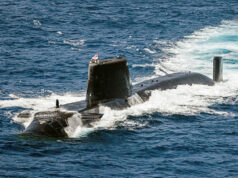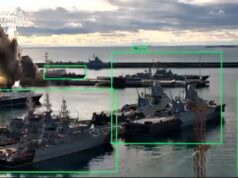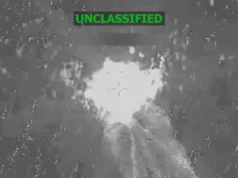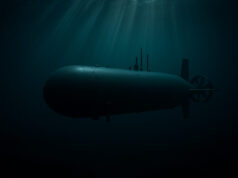When Harpoon exits service in 2023, there will be a serious capability gap, until the potential entry into service of FC/ASW programme in 2030, warns a report published by the Defence Committee.
During a committee session Lt General Sir Mark Poffley, Deputy Chief of the Defence Staff, made clear that the MoD wanted a surface to surface anti-ship missile to fill the capability gap. However, he conceded that there was not a funded line in the equipment plan for such a purchase and that it was therefore one of the MoD’s “aspirations” for the Modernising Defence Programme.
The report advised:
“Alongside the work being undertaken by the FC/ASW concept phase, the MoD should conduct a careful analysis of the various options for filling the capability gap.
This analysis should include a technical assessment of: the potential for Harpoon’s lifespan to be extended; whether other existing capabilities could be augmented to provide a stronger anti-ship function; the various off-the-shelf options that exist, including the procurement of Harpoon Block II for the P8 Maritime Patrol Aircraft; and the potential procurement of Exocet as a surface-to-surface capability for the Royal Navy.”
According to the report, which can be found here, the possible off-the-shelf alternatives that could be considered by the MoD include the following:
i) Lockheed Martin’s Long-Range Anti-Ship Missile (LRASM): the LRASM comes with both air and vertical canister launch capabilities, relies on onboard systems for target acquisition without the need for GPS navigation or external data-feeds and is able to defeat jamming and detection measures. It offers interoperability with the F-35. The LRASM will enter service for the US Air Force this year and the US Navy next year. Australia, the UK and Canada are reported to have expressed interest in the missile. Cost per unit is in the realm of $700,000–1,000,000.
ii) Naval Strike Missile (NSM): the multi-role variant of this missile, jointly developed by Kongsberg and Raytheon, would be compatible with the F-35 and would offer lower costs than the LRASM or the latest Harpoon variant. According to Raytheon, the NSM is “proven, affordable—and available today. The Naval Strike Missile is a long-range, precision strike weapon that can find and destroy enemy ships at distances up to 100 nautical miles away”. The NSM’s lifespan extends until 2040.53
iii) RBS15 Mk3: produced by Saab, the RBS15 Mk3 is, according to Naval Technology, “packed with a range of high-end features, including sophisticated electronic counter-measures (ECM) and an advanced graphical user interface [ … ] it carries a heavy, high-explosive blast and pre-fragmented warhead over a range of around 134 nautical miles and at a speed of 0.9 mach”.
iv) The MoD could seek to procure the Block II+ variant of Harpoon. The US Navy is due to introduce the Block II+ this year and it “offers greater reliability and survivability” than previous variants, including new GPS guidance and a new data link that offers “in-flight updates”, as well as improved target selectivity and “enhanced resistance to electronic countermeasures”.
v) Another alternative could be deploying the latest version of the Exocet MM40 Block 3 system. The Royal Navy operated Exocets until 2002 and according to Naval Technology, the Block 3 offers an increased range of 97 nautical miles and “a number of other enhancements and upgrades, including changes to its navigational system which now accepts GPS waypoints to enable it to use different angles of attack against naval targets and to provide a limited land-attack capability”. An upgraded Exocet model, the Block 3 C will soon be available to the French Navy and, according to Janes, offers “a new coherent active radio frequency (RF) seeker as the centrepiece of a ‘digitised’ guidance and navigation package” that should bring “significant improvements in target selectivity and electronic countermeasures performance”.













Thinking outside the box here are a few more suggestions,Japanese Type 90 (Canister),South Korean SSM-700K (Canister) and the Italian Otomat/Teseo MK2 or MK3 (Canister)
Surely the new harpoon is the obvious choice as a stop gap? I would imagine it would be the one that would require the fewest modifications to the current ships. I also think I saw somewhere that parts of the current harpoons could be used in an upgrade path to the new missile in order to reduce costs?
Didn’t the Aussies buy some cheap Block II upgrade kits for their Harpoons?
According to Gabriele Mollinelli – see link below- the UK looked at Otomat Teseo an an AShM for Type 45
http://ukarmedforcescommentary.blogspot.com/2012/04/type-26-type-45-anti-ship-missiles.html
Supposedly it has a land attack capability. It seems to have lost out in market success to Harpoon and Exocet. A Betamax in a VHS world perhaps?
http://ukarmedforcescommentary.blogspot.com/2012/04/type-26-type-45-anti-ship-missiles.html
If you want a cheaper and easier alternative to get in service quickly it has to be Harpoon Block II.
The infrastructure is in place in the Armament Depots. Handling equipment, storage, etc
The same ship mounting frames are used.
Ship equipment will be different but the power supply arrangements will already be in place for all the weird US voltages and frequencies the things need.( a legacy from needing the thing to work off aircraft)
Corporate RN knowledge is in place for emergencies and looking after the thing.
Training will need updating but Harpoon Maintainers wont find that to be an issue
Difficult to argue against Harpoon Block II. I believe our P-8s will be delivered ready wired up to take it.
It is the obvious option for all the sound reasons you outline. Plus as Paul.P says P-8 is already HBII capable.
Which means they will go with something else. Probably European. Which will a cost a fortune to implement. And perhaps will only be screwed on to the decks of a few hulls.
The USA has gone with NSM The US Navy has selected the Naval Strike Missile, offered by Raytheon Company and Kongsberg Gruppen, for over-the-horizon defence of littoral combat ships and future frigates.
Raytheon will manufacture and deliver the over-the-horizon weapon systems under a $14.8 million contract for offensive missiles loaded into launching mechanisms, and a single fire-control suite. The contract includes options which, if exercised, would bring the cumulative value to $847.6 million.
That is not for a stop gap though. We have a new very capable missile coming along in the future, we just need an effective missile to use in the meantime.
Harpoon block II is a bit of a no brainier. Phrase list can be sued on existing weapons that still have service life and all the launchers etc already in place.
Systems like NSM are nice but not a big enough leap to warrant purchase for a 7 year stop gap.
Hopefully Perseus enters service on time.
If you dig the ‘professional consensus’ in the Wardroom would be just that, with the qualifier that there is little chance the RN will need the capability unilaterally and we have lots of allies, read the USN, who can sink ships if we go to war. And we bring ‘capabilities’ that others don’t have, which is code for EW.
The likes of you and I would say the reason why our warships go to sea is primarily to sink ships of (HM’s) enemies if needed. No ‘escort’ should go to sea without that base level capability as it would be like a soldier not having a rifle to shoot (not the firearms competence is a universal in the Army). Many in the Wardroom would say that is too simplistic.
I’m not being funny but I could gaurintee if I had the money I could design a whole new harpoon replacement and fit it on a type 45 in 3 years maybe sooner, I would use already existing technology with maybe the addition of something new like better performance ect, a replacement should always be better than what it’s replacing or what’s the point in replacing it!… but why does it take so long for the UK/France replacement! It’s a dam joke!
The UK replacement is going to be a big step change. I am not sure you understand how complex these systems are and how much testing and research has to go into them. The code that runs them has to be tested to the extreme, the hardware has to go through huge amounts of development and testing.
If you had the money to do it 3 years, I’m sure you could. Unfortunately, you don’t, and neither do the UK and France.
The reason Perseus isn’t expected until around 2030 isn’t because we somehow lack the technical knowledge or ability to rapidly make the sort of jump in capability Perseus is meant to offer: it’s because it takes a lot of money, and there’s a finite yearly budget. There’s also practicalities to consider: once you have a working concept, it needs testing. Any flaws revealed may be fixable, or they may not be and you have to start from scratch. If it passed that round of tests but fails the next, you have to go back to the start. Modern weapons understandably take much longer to develop than older, simpler weapons used against softer targets
Especially when that missile is a mach 5 projectile (and all the thermal and aerodynamic issues that presents) and has double the range of harpoon has multiple warheads along with multiple modes of attack. Oh and its stealth so lots of simulations are needed to make sure it is as invisible to radar as possible… If it was easy then every country would have super advanced weapons like that… they do not.
Could we use Perseus as an air launched weapon for ground and surface attack?
With a flying start the speed on that thing would be formidable.
I’ll bet a SAM system could be modified with a larger warhead and new targeting software to act as a Mach 3 anti-ship missile. In fact, the old Sea Dart , Mach 2.5, had that capability. Not the best anti-ship missile but not nothing either.
Nath – Depends on the size and weight of it. If it’s a similar size to Storm Shadow then probably. It’d be a very formidable weapon too, so I hope it can be.
I was on about a a stop gap replacement untill th uk/France FC/ASW is ready. Using existing proved systems and building it in th UK. Not designing a whole new supersonic missile system lol. But I supose doing that you may aswell just buy a completed proven system for the stop gap or maybe blockll harpoon upgrade is what we should do and will be the cheapest option no doubt.
I thought it would be all about the money, and no doubt the FC/ASW could be designed and built far sooner if the resources were given a big cash injection.
Could the Sylver 70 VLS hold anti ship missiles? The type 45 has room for that up next to the Sylver 50 VLS. But I supose even if it could it’s money again and would cost to much! I know the Sylver 70 VLS can fire the french version of storm shadow missile/ Scalp, that would be handy on a type 45.
If you had infinite money then maybe, however there is a limit to how much you can spend and still be significantly reducing the development time. Some things just take time to develop regardless of how much money or how many resources you put to work on it.
Then there IS an ER Harpoon version out there that was offered as an LCS ASM but withdrawn in favor of the NSM.
http://seapowermagazine.org/stories/20170110-harpoon.html
Cheers!
1: Harpoon disbanding is because of support contract. So, in 2023, ALL Harppons will go suddenly.
2: Perseus ASM is PLANNED to come in 2030, as INITIAL lot.
– PLANNED –> will surely delay, no doubt.
– INITIAL –> UK will need at least 4-5 years to buy enough Perseus ASM to fill their frigates.
Clearly it means the gap is much more longer than “7 years”. It will be surely longer than 10 years (because of item-2), and even 15-20 years (including item-1). Iterium, (or replacement) is MUST.
Iterium missile could be either Harpoon block II+ or NSM or LRASM. Either may work. Happoon family has commonality with existing Hapoons on RN frigates/destroyers, and P-8 fleets. NSM is a sister of JSM, which will anyway be carried on F35B (underslung). LRASM will be a rival of Perseus ASM. But, if the “gap” is to be 20 years, LRASM will be the better option.
Anyway, just decide and pay. Either can go. If RN can go without ASM for 15-20 years, that means RN do not need Perseus ASM, no need to develop it.
LRASM Block 2, capable of launch from surface vessels is not available until 2025 at the earliest. It’s an absolute non starter. Until then LRASM Cap 1 is the only 1 available. That is certified to be fired only from the air, and only from the B-1 and F-18.
LRASM absolutely makes no sense.
Only NSM or Harpoon II is in the running.
Personally I’d like to see a a surface launched JSM developed. This could be bought in the timeframe, launched from canisters, is made in Norway who are a close and effective ally, and when FC/ASW arrives it could be left on T31 (as T31 will not need a hugely expensive ASM) and even better taken back to Kongsberg and re-lifed to air launched versions for P-8 and F-35 launch. Both of which will have had their integration paid for by Australia and Norway respectively already.
As for P-8, in the 2020-2030+ timeframe, buy a tiny number of Harpoon II for the next 10 years (think 12 in total) and sell them on to another user when JSM arrived. For any large engagement we could do the usual and borrow from the US.
Hell, surface launched JSM could be used to effectively close the Straits of Gibraltar like truck mounted Exocet was.
But in all truth an ASM is important but Sea Venom, like Sea Skua is far, far, far more likely to be used due to ROE. That and Spearfish is the real ant shipping threat from the RN. Remember the RN has never launched a heavyweight ASM in combat and they’ve had 5 (TV guided Martlet, Sea Eagle, Harpoon, Sub-Harpoon and Exocet) spread over 45 years. In comparison they have launched tens of Sea Skua.
The surface launched JSM could fill so many holes in UK capabilities its unreal:
– ASM for T31, T26 and T45 (and potentially the River B.2 deployed to the Falklands.
– Surface launch from Gibraltar
– Credible land attack for T31 and T45
– Long Term ASM for F-35 and P-8 (development already paid for)
– Credible heavyweight land attack missile for F-35 or P-8
– Could be integrated to Typhoon as an ASM (currently only Marte ER integrated). Get the Norgies to pay as a sales opportunity, whilst we pay for Stingray integration for P-8, with a very easy to deploy wingkit from MBDA). As a result no need for Mk.54 purchase.
– Temporary small purchase of Harpoon II easily recycled in 2030-35 or expended as targets.
Yes there is a lot of confusion over the current LRASM which is an air launch only urgent requirement purchase for the US and the longer term version intended to address the US Offensive Anti-Surface Warfare (OASuW)/Increment 2 program. Even the referenced parliamentary report propagates this error by stating the current LRASM is capable and qualified for ship launch when its not.
While Harpoon II+ or even Harpoon II+ ER might be options to upgrade existing UK stocks, I suspect they might also be comparatively expensive for a short term interim-only solution and a compromise, particularly wrt stealth, versus much newer missile designs. The decision by the US to go for NSM for the LCS program is telling IMO, presumably based on cost, low risk and suitability for anticipated need, versus the Harpoon II+ ER proposal that was ultimately withdrawn by Boeing.
Its also perhaps worth reflecting on if there is scope to justify support for more than one option for long term use. JSM would be an air/surface/sub launch high sub-sonic stealth solution, while Perseus would be an air/surface/sub launch hypersonic stealth solution with effectors.
Perseus is likely to be both more expensive and probably hotter than hell, so while it might not show on radar I’m betting its going to be quite observable in the IR spectrum. This might explain why the UK is currently favoring stealth and sub-sonic characteristics for the Perseus program versus the French desire for hypersonic performance, based on the comments in the Parliamentary report linked in the article. A UK dual missile strategy would provide flexibility and provide a common hypersonic specification for Perseus.
Interesting, I was curious about where the debate between stealth and speed was coming from.
Personally, I’d favour hot Mach 5 performance from a radar stealthed missile over a subsonic cold running stealth missile. IR is far less common in the sort of long range interceptors you need to stop hypersonic missiles before they’re in threat range, but even if the missile is detected, hypersonic weapons are too fast for many SAMs to stop (including Sea Ceptor)
Except there are no hypersonic missiles that have even been deployed as anti ship missiles. They are therefore a high risk strategy that should be considered experimental.
Go with Norwegian NSM. It must be good if the Cousins bought it for their Littorals. Better range and attack capability than Harpoon II and must be much cheaper than LRASM.
Also if the RAF get F35C then we can fit the newer version JSM onboard too. Unfortunately F35B bay is too small for the JSM.
I am adding this info to enhance your comment. The joint strike missile is essentially a nsm adopted to fit in the weapons bay of the f35. It is very stealthy and has had electronic signal seeker added to the passive infrared seeker so that it can target radars. It is extremely stealthy due to its use of radiabsorbent materials and shaping. The predicted detection range will give a mavimum of about 30 seconds of warning against a high quality advanced radar such as that on a type 45 destroyer. Lower quality radars will have less tine to identify and intercept. Once it reaches this final stage it carries out manouvres to reduce the chance of being hit buy a ciws.
I see this missile being used as part of a salvo of active missiles and decoys. Its primary role will be to take out the radars effectively leaving the target blind so that larger less stealthy weApons can be used to sink the ship.
People often neglect the importance of decoys in a salvo. For example. I see the role of the f35 coordinating an attack using its sensors to provide targeting information to other aircraft standing outside the detection range of the airwarfare destroyer. The f35 then fires its jsm to disable the electronics at the same time the salvo arrives. The f18e and f can carry lrasm as well as subsonic decoys. A flight of four f18 can carry 4 lrasm and 16 subsonic decoys flying at the same speed timed to saturate the defenses at the same time. The awd will have to engage 22 targets in such a scenario. Once you start using supersonic anti ship missiles it is quite easy for the target to determine what is a threat. In addition long range supersonic missiles as well as decoys have to be large by there very nature limiting salvo size. As a result there is no such thing as a supersonic decoy. To achieve the same salvo you would need 22 aircraft the size of of an su 30 to acheive the same effect.
For these reasons i think that stealthy sub sonic anti ship are more likely to penetrate a modern air warfare destroyers defense system. I think this is the major reason that western nations are not going down the supersonic route.
A small number of block 11 Harpoon is the obvious choice as we only need enough to fit deployed ships rather like the way Phalanx is fitted.They could then be removed from their tubes when no longer needed and modified to air launch on P8.
Probably to logical for the MOD though.
It’s another Gamble though, Just like the Decisions to Get rid of the Harriers, Nimrods and Carriers. The Gamble only works in times of peace. B.T.W., Zircon and BrahMos are already here in 2018, some 12 years ahead of anything “We” might eventually have.
Brahmos is just an Indian built variant of the Soviet Sunburn which has been around for ages and Zircon has not even been tested yet.
Yes GWM, I know. But They are here now, hence my post. I believe the PLAN will have their own version soon too.
Exactly, the indians kept saying they invented and created the dam Brahmos missile! It was a dam Russian system to begin with… Indians online keep pissing me off, they seem to think they are the best millitary force on earth with the best equipment! Even though they buy most of there junk abroad….
The way to make a weapon expensive, is to scrap it at the end of its shelf life, unused. The way to reduce the chances of this in an ASM is to give it the capability of striking land targets. It would be interesting to know how many times land attack missiles have been launched cf ASMs but it’s sure to be by a large margin.
I would have thought in this day and age, the two types would automatically be combined. Maybe I’m looking at it too simply, but I thought the issue in the asw role was tracking a moving target whilst in flight. Just give them all the right seekers, data link etc to course correct during flight?
An issue of the large long range missiles is their cost, and how likely is it one single missile will get through? You would probably have to fire 3 or 4 simultaneously to ensure a kill against a large first rate ship with all the defensive weaponry these days.
I wonder whether it would be best to develop something along the lines of a long range carrier missile that holds multiple smaller short range ram jet missiles such as brimstone which are networked and work intelligently together. Idea being they are carried within range, separate from the carrier missile and swarm the opposing vessel, each following different trajectories and angles of attack. Some get through and hit the vessel, blinding it and taking out certain systems (radar, bridge, ciws etc). Then whilst they are reeling, in follows as Lrasm heavy warhead type missile to sink it almost unopposed. Say
Cost £2 million with an almost guaranteed kill, not £4 million.
That seems imensely logical certainly in the medium them when a single missile strike/type might become far more easily thwRted than not. We all talk about missiles here and though related it’s interesting to examine the tactics and. On inactions related to those missile types to make strike capabilities greater than the sum of the parts. Great insight if only to make us think more in those terms.
For a flexible option, how about the V24-7 Vigilant armed with Spear 3?
http://bellflight.com/military/bell-v-247
https://ukdefencejournal.org.uk/spear-3-important/
Funny you mention that T.S
https://nationalinterest.org/blog/buzz/navy-wants-swarm-weapons-can-do-something-amazing-38662
Cheers!
I wonder if a future tie in with Kongsberg and Raytheon might be possible to continue developing Perseus? If so, this might be a sensible short-term solution for both land and sea.
Naval Strike Missile.
https://www.defensenews.com/naval/2018/07/20/the-us-navys-new-anti-ship-missile-scores-a-hit-at-rimpac-but-theres-a-twist/
Just thinking out loud. I can’t help but notice how the Russians are fitting long range AShM and ASuM to the Bears and Blackjacks. I would prefer to see Harpoon Block II purchase prioritised for the P-8 fleet, which like many I would like to see increased. Poseidon P-8 equipped with Harpoon Block II pre-positioned on UK sovereign basis could control a vast sea area of the globe relatovely cheaply?, reducing the need for every ship in the RN fleet to carry an expensive AShM. A River 2 or lightly armed T31 ‘patrol’ frigate in dire straits would have ‘air support’ a few hrs away. Perhaps only T26 and the ‘batch 2’ Type 31s would have an AShM. Harpoon II would be the favourite gap filling solution and would eventually give way to LRASM or Perseus or whatever.
We won’t have enough P8 to cover their primary roles never mind adding to them.
I understand. I’m just trying to think out of the box. Another example; its just 4000km from Diego Garcia to Nairobi, which would put a large area of the Indian Ocean in range of a Typhoon carrying Marte-ER AshM; which I believe has or is close to being integrated onto the aircraft. Just trying to think of cheap alternatives to wholesale fleet investment in missiles which are seldom used.
Credit to the people in power to have the guts to highlight this serious issue.
We must not allow our ships & task groups to deploy without the essential kit. We must have an anti-ship missile for our escorts to cover us until Pereuss comes into service. An air launched one too for helicopters & MPA.
Serious capability gaps gamble with the lives of our sailors & the security of the nation. Wars tend to throw up unforeseen & unconventional threats which make even sensible precautions or thinking obsolete, let alone criminally removing basic weaponry such as ASMs. Some wars happen without allies, like the Falklands did.
On paper our likely enemies have far more capable ASMs than the west, deployed now, rather than in 10 years time. I don’t mind what we get much as long as we don’t leave our far too few ships to be wiped out before we get within our own engagement range.
It’s like trying to win the FA cup with only a 5-a-side squad.
Perseus!
So in essence unless the MOD & RN listen we will be 15-20 years without such a weapon.
Can you imagine the RAF or Army getting themselves into such a mess ? Yeah we have bombs but no air to air missiles…..
The carriers are great but a fleet of 12 type 45’s armed to the gills with cruise / NsM / BMD and 12 astutes would have made the US even happier and cemented the RN as indisposable to NATO.
Given the size of the Russian surface fleet and the remote chance of engaging the Chinese Navy, I think surface to surface warfare should be a secondary focus for the RN. Having said that, we still need the capability to hold a hostile ship at some distance. Subsonic non stealthy and non-maneuverable missiles are obsolete. So why not work on an anti-ship capability for Aster 30 and Sea Ceptor? The US did that it with SM6. We would have instant supersonic anti-ship capability. The benefits would be 1) we wouldn’t need to add a new missile type 2) we could launch saturation attacks and 3) we wouldn’t need to modify our frigates with new launchers. The disadvantages would be 1) small warheads relative to the missiles mentioned in the article (but that would be to some degree mitigated by the huge increase in kinetic energy due to the speed of the missiles) and 2) strain on the number of tubes available. This last disadvantage could be mitigates for the frigates by quad-packing Sea Ceptors. It could not for the destroyers.
Someone, please help me out here. I know that Harpoon is coming to the end of its life span and will be replaced by newer and more advanced systems, but why does everyone say that it will be phased out in 2023.
As far as I am aware several European navies with new ship construction such as the Iver Huitfeldt class and Sachsen class as well as the Hobart class which is slightly older have all got Harpoon missiles. It does not seem logical for a class of vessel that has only entered service in 2017 to be fitted with a weapon and its associated sensors that will be obsolete 6 years later.
Also as far as I understand is there not an upgrade package for the Block 1C to Block II+ which went into production in 2017.
Or am I missing something?
Or buy some fast missiles from India.